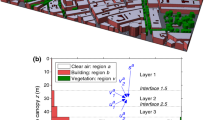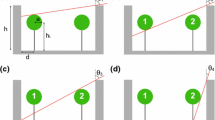Abstract
The influence of building geometry on the radiation terms ofthe surface energy balance is a principal reason for surfacetemperature differences between rural and urban areas.Methods exist to calculate the radiation balance in an urban area,but their validity across the range of urban geometries andmaterials has not been carefully considered.Here the exchange of diffuse radiation in an urban street canyon isinvestigated using a method incorporating all reflections of radiation.This exact solution is compared to two commonly used approximationsthat retain either no reflections, or just one reflection of radiation.The area-averaged net radiative flux density from the facets of the canyondecreases in magnitude monotonically as the canyon aspect ratio increases.The two approximate solutions possess unphysical differences from thismonotonic decrease for high canyon aspect ratios or low materialemissivities/high material albedos.The errors of the two approximate solutions are small for near blackbodymaterials and small canyon aspect ratios but can be an order ofmagnitude for intermediate material properties and deep street canyons.Urban street canyon models need to consider at least one reflectionof radiation and multiple reflections are desirable for full applicability.
Similar content being viewed by others
References
Aida, M. and Gotoh, K.: 1982, 'Urban Albedo as a Function of the Urban Structure-A Two-Dimensional Numerical Simulation', Boundary-Layer Meteorol. 23, 415-424.
Arnfield, A. J.: 1982, 'An Approach to the Estimation of the Surface Radiative Properties and Radiation Budgets of Cities', Physical Geog. 3, 97-122.
Arnfield, A. J. and Grimmond, C. S. B.: 1998, 'An Urban Canyon Energy Budget Model and its Application to Urban Storage Heat Flux Modelling', Energ. Buildings 27, 61-68.
Johnson, G. T. and Watson, I. D.: 1984, 'The Determination of View-Factors in Urban Canyons', J. Climatol. Appl. Meteorol. 23, 329-335.
Johnson, G. T., Oke, T. R., Lyons, T. J., Steyn, D. G., Watson, I. D., and Voogt, J. A.: 1991, 'Simulation of Surface Urban Heat Islands under 'Ideal' Conditions at Night. Part 1: Theory and Tests against Field Data', Boundary-Layer Meteorol. 56, 275-294.
Kobayashi, T. and Takamura, T.: 1994, 'Upward Longwave Radiation from a Non-Black Urban Canopy', Boundary-Layer Meteorol. 69, 201-213.
Kusaka, H., Kondo, H., Kikegawa, Y., and Kimura, F.: 2001, 'A Simple Single-Layer Urban Canopy Model for Atmospheric Models: Comparison with Multi-Layer and Slab Models', Boundary-Layer Meteorol. 101, 329-358.
Masson, V.: 2000, 'A Physically-Based Scheme for the Urban Energy Budget in Atmospheric Models', Boundary-Layer Meteorol. 94, 357-397.
Mills, G. M.: 1993, 'Simulation of the Energy Budget of an Urban Canyon-I. Model Structure and Sensitivity Test', Atmos. Environ. 27B, 157-170.
Nakamura, Y. and Oke, T. R.: 1988, 'Wind, Temperature and Stability Conditions in an East-West Oriented Urban Canyon', Atmos. Environ. 22, 2691-2700.
Noilhan, J.: 1981, 'A Model for the Net Total Radiation Flux at the Surfaces of a Building', Building Environ. 16, 259-266.
Nunez, M. and Oke, T. R.: 1977, 'The Energy Balance of an Urban Canyon', J. Appl. Meteorol. 16, 11-19.
Oke, T. R.: 1987, Boundary Layer Climates, Chapter 8, 2nd edn., Routledge, pp. 262-303.
Owczarek, S.: 1997, 'Vector Model for Calculation of Solar Radiation Intensity and Sums Incident on Tilted Surfaces. Identification for the Three Sky Condition in Warsaw', Renew. Energ. 11, 77-96.
Sakakibara, Y.: 1996, 'A Numerical Study of the Effect of Urban Geometry upon the Surface Energy Budget', Atmos. Environ. 30, 487-496.
Sparrow, E. M. and Cess, R. D.: 1970, Radiation Heat Transfer, Chapters 3-4, Appendices A &; B, Thermal Science Series, Brooks/Cole, pp. 75-136, 300-313.
Steyn, D. G. and Lyons, T. J.: 1985, 'Comment on “The Determination of View-Factors in Urban Canyons” ', J. Climatol. Appl. Meteorol. 24, 383-385.
Verseghy, D. L. and Munro, D. S.: 1989a, 'Sensitivity Studies on the Calculation of the Radiation Balance of Urban Surfaces: I. Shortwave Radiation', Boundary-Layer Meteorol. 46, 309-331.
Verseghy, D. L. and Munro, D. S.: 1989b, 'Sensitivity Studies on the Calculation of the Radiation Balance of Urban Surfaces: II. Longwave Radiation', Boundary-Layer Meteorol. 48, 1-18.
Voogt, J. A. and Oke, T. R.: 1998, 'Radiometric Temperatures of Urban Canyon Walls Obtained from Vehicle Traverses', Theor. Appl. Climatol. 60, 199-217.
Author information
Authors and Affiliations
Rights and permissions
About this article
Cite this article
Harman, I.N., Best, M.J. & Belcher, S.E. Radiative Exchange in an Urban Street Canyon. Boundary-Layer Meteorology 110, 301–316 (2004). https://doi.org/10.1023/A:1026029822517
Issue Date:
DOI: https://doi.org/10.1023/A:1026029822517




